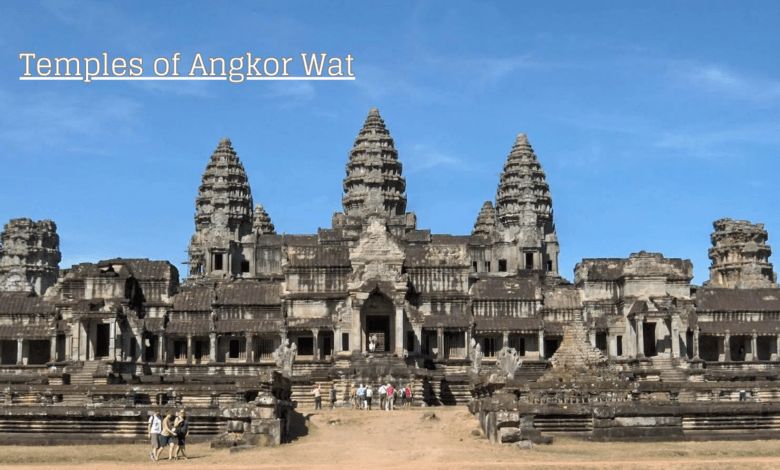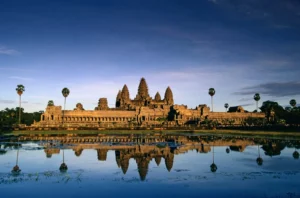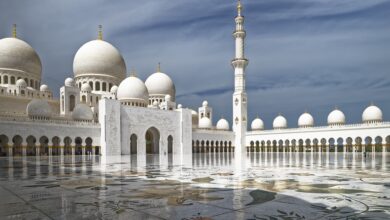🏛️ The Ancient Temples of Angkor Wat: Cambodia’s Architectural Marvels 🇰🇭
Delve into the Mysteries and Magnificence of Angkor Wat's Timeless Temples

Introduction
Nestled amidst the lush jungles of Cambodia lies a testament to human ingenuity and spiritual devotion – the ancient temples of Angkor Wat. As one of the world’s most magnificent architectural marvels, Angkor Wat continues to captivate the imagination of travelers, historians, and archaeologists alike.
In this blog post, we will embark on a journey through time to unravel the secrets and significance of this awe-inspiring complex. From its enigmatic origins to its intricate design, from its cultural importance to the experience of modern-day visitors, Angkor Wat stands as a testament to the grandeur of human creativity and spiritual dedication. Join us as we explore the mystical world of Cambodia’s Angkor Wat, a treasure trove of history and wonder.
History of Angkor Wat
→ Origins and Construction
Angkor Wat, located in Cambodia, is a UNESCO World Heritage Site and one of the most iconic religious monuments in the world. Its origins date back to the early 12th century when it was constructed by King Suryavarman II of the Khmer Empire. The temple was built as a dedication to the Hindu god Vishnu but later transformed into a Buddhist site. The construction of Angkor Wat is a testament to the architectural and engineering prowess of the Khmer civilization.
The construction of Angkor Wat is a remarkable feat in itself. It spans over 162.6 hectares (1.626 square kilometers) and is surrounded by a massive moat and a series of walls. The temple complex consists of five central towers, each representing the peaks of Mount Meru, the mythical home of the gods in Hindu cosmology. The entire structure was built using sandstone blocks, quarried from a location around 40 kilometers away and transported to the site. The precision with which the stones were carved and placed is a testament to the advanced construction techniques of the time.
→ Architectural Features
Angkor Wat’s architectural features are a marvel to behold. The central sanctuary is accessed through a series of galleries and courtyards, each adorned with intricate bas-reliefs that depict scenes from Hindu epics like the Mahabharata and the Ramayana. The temple’s central towers rise to a height of 65 meters and are surrounded by smaller towers and libraries. The entire complex is designed to represent the cosmos, with the central tower symbolizing Mount Meru, and the moat symbolizing the oceans that surround it.
One of the most striking features of Angkor Wat is its elaborate bas-reliefs, which cover over 2,000 square meters of the temple’s walls. These reliefs depict not only religious and mythological scenes but also scenes from daily life in the Khmer Empire, offering a unique glimpse into the culture of the time. The precision and detail in these carvings are a testament to the artistic skill of the Khmer craftsmen.
Read more on Wikipedia.org
→ Cultural and Religious Context
Angkor Wat’s transformation from a Hindu temple to a Buddhist one reflects the dynamic religious and cultural history of the region. While initially dedicated to Vishnu, it was later converted into a Buddhist temple, and today it continues to serve as an important pilgrimage site for Buddhists. This transition symbolizes the peaceful coexistence and interchange of Hinduism and Buddhism in Southeast Asia.
In its cultural context, Angkor Wat is a symbol of the Khmer Empire’s power and grandeur during its zenith. The temple’s construction was not just a religious endeavor but also a political statement, showcasing the might and influence of the Khmer rulers. Today, Angkor Wat stands as a symbol of national pride for Cambodia and attracts millions of visitors from around the world who come to admire its architectural beauty and immerse themselves in its rich history and spirituality.

Architectural Marvels
-
Layout and Design
Architectural marvels often push the boundaries of human creativity and engineering, and one such masterpiece is the layout and design of Angkor Wat. This awe-inspiring temple complex, located in Cambodia, is a prime example of ancient Khmer architecture. The layout of Angkor Wat is meticulously planned, reflecting a harmonious fusion of art and science.
At its core, Angkor Wat is designed as a representation of the Hindu cosmos, with its central tower symbolizing Mount Meru, the mythical home of the gods. The temple’s architectural design is a reflection of Khmer cosmology and religious beliefs. It features a series of concentric galleries and courtyards, with the central sanctuary being the ultimate destination. The temple’s alignment with cardinal directions and precise measurements demonstrate the advanced knowledge of astronomy and mathematics possessed by the Khmer civilization.
-
Bas-Reliefs and Carvings
One of the most striking aspects of Angkor Wat’s architectural marvel is its intricate bas-reliefs and carvings. Stretching over 2,000 square meters, these intricate stone carvings adorn the temple’s walls, capturing not only religious and mythological stories but also scenes from daily life during the Khmer Empire’s zenith.
These bas-reliefs are like a visual encyclopedia, providing a window into the cultural, historical, and artistic achievements of the time. They depict episodes from Hindu epics such as the Mahabharata and the Ramayana, as well as intricate narratives of battles, royal processions, and celestial beings. The level of detail and craftsmanship is astounding, showcasing the Khmer artisans’ exceptional skills.
-
Moat and Causeway
The moat and causeway surrounding Angkor Wat add a layer of mystique and grandeur to its architectural marvel. The moat, measuring 190 meters wide and spanning 1.5 kilometers in length, is a feat of engineering itself. It not only serves as a defensive feature but also symbolizes the cosmic ocean that surrounds Mount Meru.
The causeway, a raised walkway leading to the temple’s entrance, is equally impressive. Lined with statues of guardian deities, it represents the path to enlightenment. The causeway’s layout and design are a testament to the meticulous planning and attention to detail that went into every aspect of Angkor Wat’s construction.
Cultural Significance
→ Religious Importance
The cultural significance of Angkor Wat is deeply rooted in its religious importance. Originally constructed as a Hindu temple in the 12th century, Angkor Wat was dedicated to the Hindu god Vishnu, and its architecture and iconography reflect Hindu cosmology and mythology. The temple’s central tower symbolizes Mount Meru, the mythical abode of the gods in Hinduism, making it a sacred site for Hindu worship.
Over time, Angkor Wat underwent a transformation, converting to Buddhism, and this transition adds an additional layer of religious significance. Today, the temple remains an active place of Buddhist worship, attracting pilgrims and monks who come to meditate and offer prayers. This blend of Hindu and Buddhist heritage underscores the cultural and religious dynamism of Angkor Wat, making it a symbol of the harmonious coexistence of these two major religions in Southeast Asia.
→ Role in Khmer History
Angkor Wat played a pivotal role in Khmer history, serving as the political, cultural, and religious heart of the Khmer Empire during its zenith. The temple complex wasn’t merely a place of worship but also a statement of the empire’s grandeur and power. It served as the state temple and a royal palace, emphasizing the divine authority of the Khmer kings.
The historical importance of Angkor Wat is evident in the numerous inscriptions and carvings that chronicle the accomplishments and reigns of Khmer rulers. The temple complex is a tangible testament to the architectural and artistic achievements of the Khmer civilization, providing valuable insights into their society, governance, and culture.
→ UNESCO World Heritage Site
In 1992, Angkor Wat was designated as a UNESCO World Heritage Site, underscoring its global cultural significance. This recognition places it among the world’s most cherished cultural treasures and acknowledges its outstanding universal value. As a World Heritage Site, Angkor Wat enjoys international protection and support for its preservation and conservation efforts.
The UNESCO designation also highlights Angkor Wat’s role in promoting cultural exchange and understanding. It attracts millions of tourists and researchers from around the world, fostering a deeper appreciation of Cambodia’s rich heritage and the broader history of Southeast Asia.
Visitor Experience
1. Tourist Attractions within Angkor Wat
Angkor Wat offers visitors a wealth of remarkable attractions and experiences within its sprawling temple complex. Some of the key highlights include:
- Central Sanctuary: The heart of Angkor Wat, the central sanctuary, is a must-visit. It houses a statue of the Buddha and offers a serene atmosphere for meditation and reflection.
- Bas-Reliefs: Explore the intricate bas-reliefs that adorn the temple’s walls. These carvings depict epic stories, mythical creatures, and scenes from daily life in ancient Khmer society.
- Library Courtyards: Stroll through the library courtyards, which provide beautiful perspectives of the temple’s architecture and intricate stone carvings.
- Terraces: Visit the terraces that surround the temple. The Terrace of the Elephants and the Terrace of the Leper King are particularly noteworthy for their impressive carvings and historical significance.
- Reflecting Pools: Enjoy the reflection of Angkor Wat in the surrounding pools, especially during sunrise or sunset, when the temple is bathed in a warm, ethereal light.
2. Visitor Tips and Guidelines
To enhance your visit to Angkor Wat and contribute to its preservation, consider the following tips and guidelines:
- Respect Dress Code: Dress modestly by covering your shoulders, chest, and knees. This is not only a sign of respect but also a requirement for entry.
- Quiet and Respectful Behavior: Maintain a respectful demeanor within the temple complex. Angkor Wat is still an active religious site for Buddhists, so be mindful of those who come to worship and meditate.
- Stay on Designated Paths: Stick to designated paths and platforms when exploring the temple. Climbing on the temple structures or touching the carvings can cause damage.
- Sun Protection: Cambodia’s climate can be hot and sunny. Wear sunscreen, a hat, and sunglasses, and stay hydrated throughout your visit.
- Engage Local Guides: Consider hiring a local guide to gain deeper insights into the history and significance of Angkor Wat. They can provide valuable context and make your visit more enriching.
- Purchase Tickets: Obtain your entrance pass at the official ticketing booth. Keep it with you at all times, as you may be asked to show it at various checkpoints.
3. Preserving the Site for Future Generations
Preserving Angkor Wat for future generations is crucial to ensure its cultural legacy endures. Here are some ways to contribute to its conservation:
- Follow Preservation Guidelines: Adhere to all posted guidelines and instructions to minimize the impact of tourism on the site.
- Support Conservation Efforts: Consider making a donation to organizations dedicated to preserving Angkor Wat and other archaeological sites in Cambodia.
- Responsible Photography: When taking photos, be mindful of not using flash in dimly lit areas, as it can damage delicate artwork over time.
- Avoid Vandalism: Never deface or graffiti the temple’s walls or structures. Such actions can irreparably harm this historic treasure.
- Spread Awareness: Share your experiences responsibly on social media, encouraging others to visit Angkor Wat with respect for its cultural and historical significance.
By following these guidelines and being conscientious visitors, we can all play a role in safeguarding Angkor Wat for future generations, ensuring that this extraordinary cultural treasure continues to inspire and captivate people from around the world.
FAQs (Frequently Asked Questions)
Q: How old is Angkor Wat?
A: The exact age of Angkor Wat remains a subject of debate, but it is believed to have been constructed in the 12th century.
Q: What is the significance of the five central towers in Angkor Wat?
A: The five central towers represent the peaks of Mount Meru, a sacred mountain in Hindu mythology.
Q: Can visitors enter the central towers of Angkor Wat?
A: No, access to the central towers is restricted to preserve their structural integrity.
Q: Is Angkor Wat still used for religious purposes today?
A: While it is no longer a primary site for religious worship, Buddhist rituals and ceremonies are occasionally held at Angkor Wat.
Q: How can I contribute to the preservation of Angkor Wat?
A: You can support preservation efforts by visiting responsibly, following conservation guidelines, and donating to organizations dedicated to safeguarding the temple complex.
Q: What is the best time to visit Angkor Wat?
A: Sunrise and sunset offer the most breathtaking views and a serene atmosphere. Plan your visit during these times for an unforgettable experience.
Conclusion
In conclusion, the ancient temples of Angkor Wat are not merely stone structures but living witnesses to the rich tapestry of Cambodia’s history and culture. As we reflect on the beauty and complexity of this architectural marvel, we must also recognize our responsibility to preserve it for generations to come.
The magic of Angkor Wat lies not only in its physical grandeur but also in the stories it tells and the questions it raises about the past. So, as you plan your next adventure, consider embarking on a journey to Cambodia, where the echoes of the Khmer Empire still resonate in the corridors of Angkor Wat. Let us be stewards of this cultural treasure, ensuring that it continues to inspire and awe all those who come to marvel at its splendor.
Up Next
🍽️ Cultural Diversity in New York City: Exploring Neighborhoods and Cuisine 🌆





Facebook Comments